View in other NatureServe Network Field Guides
NatureServe
Montana
Utah
Wyoming
Idaho
Wisconsin
British Columbia
South Carolina
Yukon
California
New York
General Description
Swift foxes are North America's smallest native canid (Foresman 2012), weighing 1.8 to 3.0 kilograms, with males averaging larger than females. The winter pelage is dark buffy-gray above, and orange-tan on the sides, legs, and lower surface of the tail. The chest and belly are buff to white and the tail is tipped with black. In summer the coat is shorter, harsher, and more reddish. The length of the head and body is 38 to 53 centimeters and tail length is 23 to 35 centimeters. The length of the ear of adults is 56 to 78 millimeters (Clark and Stromberg 1987, Nowak 1991).
Diagnostic Characteristics
The swift fox is one-fifth the size (weight) of a coyote; it is also smaller than the red fox and differs by having a black-tipped tail (Foresman 2012).
Species Range
Montana Range
Range Descriptions
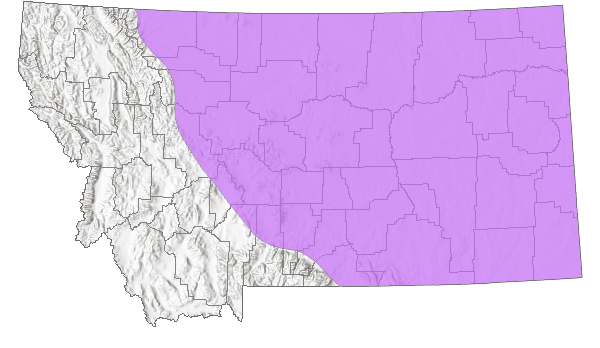
 Native
Native
Western Hemisphere Range
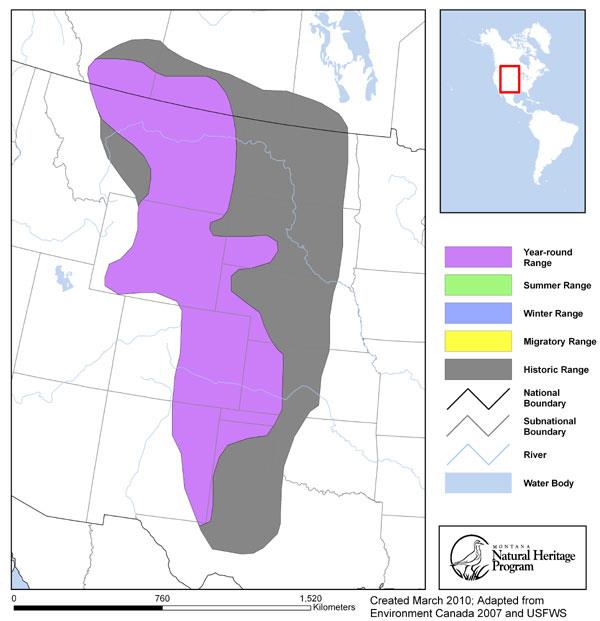
Observations in Montana Natural Heritage Program Database
Number of Observations: 695
(Click on the following maps and charts to see full sized version)
Map Help and Descriptions
Relative Density

Recency
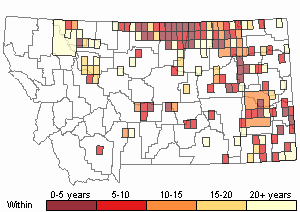

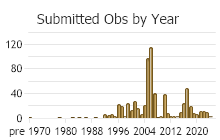
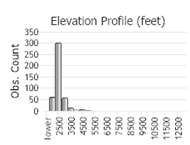 (Observations spanning multiple months or years are excluded from time charts)
(Observations spanning multiple months or years are excluded from time charts)
Migration
Swift foxes are year-round residents.
Habitat
Swift foxes inhabit open prairie and arid plains, including areas intermixed with winter wheat fields in north-central Montana. They use burrows when they are inactive; either dug by themselves or made by other mammals (marmot, prairie dog, badger). The burrows are usually located in sandy soil on high ground such as hill tops (Pruss 1999) in open prairies, along fence rows, or occasionally in a plowed field. An individual may use several different dens throughout the year.
A statewide assessment of swift fox habitat was conducted by the Department of Fish, Wildlife, and Parks in May 1994 to identify large blocks of prairie grassland. Suitable swift fox habitat was generally defined as extensive in size (preferably over 100,000 acres), with relatively level topography, and with greater than 50% of the area undisturbed by agriculture. A total of 8,000,000 suitable acres were identified in Montana (Giddings and Knowles 1995). In Canada and northern Montana, Moehrenschlager et al. (2006) found that swift foxes were more likely to be present in relatively dry areas with gently sloping terrain, and less likely to be found in cropland or in edges, roads and other features related to habitat fragmentation.
Ecological Systems Associated with this Species
- Details on Creation and Suggested Uses and Limitations
How Associations Were Made
We associated the use and habitat quality (common or occasional) of each of the 82 ecological systems mapped in Montana for
vertebrate animal species that regularly breed, overwinter, or migrate through the state by:
- Using personal observations and reviewing literature that summarize the breeding, overwintering, or migratory habitat requirements of each species (Dobkin 1992, Hart et al. 1998, Hutto and Young 1999, Maxell 2000, Foresman 2012, Adams 2003, and Werner et al. 2004);
- Evaluating structural characteristics and distribution of each ecological system relative to the species' range and habitat requirements;
- Examining the observation records for each species in the state-wide point observation database associated with each ecological system;
- Calculating the percentage of observations associated with each ecological system relative to the percent of Montana covered by each ecological system to get a measure of "observations versus availability of habitat".
Species that breed in Montana were only evaluated for breeding habitat use, species that only overwinter in Montana were only evaluated for overwintering habitat use, and species that only migrate through Montana were only evaluated for migratory habitat use.
In general, species were listed as associated with an ecological system if structural characteristics of used habitat documented in the literature were present in the ecological system or large numbers of point observations were associated with the ecological system.
However, species were not listed as associated with an ecological system if there was no support in the literature for use of structural characteristics in an ecological system,
even if point observations were associated with that system.
Common versus occasional association with an ecological system was assigned based on the degree to which the structural characteristics of an ecological system matched the preferred structural habitat characteristics for each species as represented in scientific literature.
The percentage of observations associated with each ecological system relative to the percent of Montana covered by each ecological system was also used to guide assignment of common versus occasional association.
If you have any questions or comments on species associations with ecological systems, please contact the Montana Natural Heritage Program's Senior Zoologist.
Suggested Uses and Limitations
Species associations with ecological systems should be used to generate potential lists of species that may occupy broader landscapes for the purposes of landscape-level planning.
These potential lists of species should not be used in place of documented occurrences of species (this information can be requested at:
mtnhp.org/requests) or systematic surveys for species and evaluations of habitat at a local site level by trained biologists.
Users of this information should be aware that the land cover data used to generate species associations is based on imagery from the late 1990s and early 2000s and was only intended to be used at broader landscape scales.
Land cover mapping accuracy is particularly problematic when the systems occur as small patches or where the land cover types have been altered over the past decade.
Thus, particular caution should be used when using the associations in assessments of smaller areas (e.g., evaluations of public land survey sections).
Finally, although a species may be associated with a particular ecological system within its known geographic range, portions of that ecological system may occur outside of the species' known geographic range.
Literature Cited
- Adams, R.A. 2003. Bats of the Rocky Mountain West; natural history, ecology, and conservation. Boulder, CO: University Press of Colorado. 289 p.
- Dobkin, D. S. 1992. Neotropical migrant land birds in the Northern Rockies and Great Plains. USDA Forest Service, Northern Region. Publication No. R1-93-34. Missoula, MT.
- Foresman, K.R. 2012. Mammals of Montana. Second edition. Mountain Press Publishing, Missoula, Montana. 429 pp.
- Hart, M.M., W.A. Williams, P.C. Thornton, K.P. McLaughlin, C.M. Tobalske, B.A. Maxell, D.P. Hendricks, C.R. Peterson, and R.L. Redmond. 1998. Montana atlas of terrestrial vertebrates. Montana Cooperative Wildlife Research Unit, University of Montana, Missoula, MT. 1302 p.
- Hutto, R.L. and J.S. Young. 1999. Habitat relationships of landbirds in the Northern Region, USDA Forest Service, Rocky Mountain Research Station RMRS-GTR-32. 72 p.
- Maxell, B.A. 2000. Management of Montana's amphibians: a review of factors that may present a risk to population viability and accounts on the identification, distribution, taxonomy, habitat use, natural history, and the status and conservation of individual species. Report to U.S. Forest Service Region 1. Missoula, MT: Wildlife Biology Program, University of Montana. 161 p.
- Werner, J.K., B.A. Maxell, P. Hendricks, and D. Flath. 2004. Amphibians and reptiles of Montana. Missoula, MT: Mountain Press Publishing Company. 262 p.
- Commonly Associated with these Ecological Systems
Grassland Systems
Recently Disturbed or Modified
- Occasionally Associated with these Ecological Systems
Grassland Systems
Recently Disturbed or Modified
Shrubland, Steppe and Savanna Systems
Sparse and Barren Systems
Wetland and Riparian Systems
Food Habits
Diet consists of small mammals (jack rabbits, cottontails, and mice), birds, and invertebrates, with small mammals comprising the bulk of the diet (Foresman 2012). Swift foxes cache excess food under snow in winter (Banfield 1974).
Ecology
Predation was the major cause of mortality on the Blackfeet Reservation, with coyotes the major predators, followed by raptors (Ausband and Foresman 2007a). Dispersal distance averages around 11 kilometers, with an observed maximum of only 64 kilometers (Mercure et al. 1993); on the Blackfeet Reservation, dispersal averaged 10.4 km (Ausband and Foresman 2007b). Swift foxes may range over several square kilometers during a single night. Density of a locally abundant population in Wyoming was reported as one pair per 5 to 8 square kilometers (Clark and Stromberg 1987).
Swift foxes were very susceptible to trapping and poisoning for gray wolves and coyotes in the early 1900s (Hoffmann and Pattie 1968). These practices have been discontinued, but the ecological community of the grassland environment may nonetheless be in an altered state, with the niche once occupied by swift fox restricted by decreased prey availability or increased competition with coyotes (Giddings and Knowles 1995). Swift foxes are considered to be an active disperser, and states and provinces adjacent to Montana should be recognized as natural sources of dispersing animals.
Reproductive Characteristics
In Montana, the breeding season extends from late December to early March, with litters born in late March to early May (Foresman 2012). Litter size usually is 3 to 6 (Egoscue 1979); on the Blackfeet Reservation, litter size was 3.3-4.1 (Ausband and Foresman 2007a). Swift foxes produce one litter per year and young are born in an underground den about 1 meter below the ground surface (Banfield 1974). Dens usually have multiple entrances and may be 3 to 6 meters long. Disturbance may cause the female to move young to a different den. Pups first emerge from the den at about 1 month of age (by June 1 in Wyoming). Young are tended by both sexes and disperse in late summer to early fall. Pair-bonds may be life-long.
Management
Swift foxes were thought to be common on the eastern plains of Montana in the early 1900's but were exterminated and believed to be extinct in the state by 1969 (Hoffmann et al. 1969). Sporadic observations throughout eastern Montana have been recorded since 1969 and reintroductions of swift fox on the Blackfoot Indian Reservation in northwestern Montana in 1998 (Foresman 2012) and in southern Saskatchewan and Alberta from 1983 to 1991 are thought to be the source of many of these sightings. These populations continue to expand to the south and east in Montana. Recent surveys in Montana have documented swift fox in many of the counties bordering Canada in north-central Montana (Moehrenschlager and Moehrenschlager 2001). A trapping season for swift fox was recently reestablished in Montana Fish, Wildlife, and Parks Region 6. For the latest information on trapping see Montana Fish, Wildlife, and Parks'
Furbearing Trapping Guide.
References
- Literature Cited AboveLegend:
 View Online Publication
View Online Publication Banfield, A. W. F., and Allan Brooks. 1981. The mammals of Canada. Toronto, ON: University of Toronto Press.
Banfield, A. W. F., and Allan Brooks. 1981. The mammals of Canada. Toronto, ON: University of Toronto Press. Clark, S.G. and M.R. Stromberg. 1987. Mammals in Wyoming. University of Kansas Museum of Natural History, Public Education Series Number 10. xii + 314 pp.
Clark, S.G. and M.R. Stromberg. 1987. Mammals in Wyoming. University of Kansas Museum of Natural History, Public Education Series Number 10. xii + 314 pp. Egoscue, H. J. 1979. Vulpes velox. Mammalian Species 122:1-5.
Egoscue, H. J. 1979. Vulpes velox. Mammalian Species 122:1-5. Foresman, K.R. 2012. Mammals of Montana. Second edition. Mountain Press Publishing, Missoula, Montana. 429 pp.
Foresman, K.R. 2012. Mammals of Montana. Second edition. Mountain Press Publishing, Missoula, Montana. 429 pp. Giddings, B. and C. J. Knowles. 1995. The current status of swift fox in Montana. In: Allen, S. H., J. W. Hoagland, and E. D. Stukel, eds. pp. 101-105. Report of the Swift Fox Conservation Team. 170 p.
Giddings, B. and C. J. Knowles. 1995. The current status of swift fox in Montana. In: Allen, S. H., J. W. Hoagland, and E. D. Stukel, eds. pp. 101-105. Report of the Swift Fox Conservation Team. 170 p. Hoffmann, R.S. and D.L. Pattie. 1968. A guide to Montana mammals: identification, habitat, distribution, and abundance. Missoula, MT: University of Montana. 133 p.
Hoffmann, R.S. and D.L. Pattie. 1968. A guide to Montana mammals: identification, habitat, distribution, and abundance. Missoula, MT: University of Montana. 133 p. Mercure, A., K. Ralls, P. K. P. Koepfli, and R. K. Wayne. 1993. Genetic subdivisions among small canids: mitochondrial DNA differentiation of swift, kit, and arctic foxes. Evolution 47:1313-1328.
Mercure, A., K. Ralls, P. K. P. Koepfli, and R. K. Wayne. 1993. Genetic subdivisions among small canids: mitochondrial DNA differentiation of swift, kit, and arctic foxes. Evolution 47:1313-1328. Moehrenschlager, A. and C. Moehrenschlager. 2001. Census of swift fox (Vulpes velox) in Canada and northern Montana, 2000-2001. Edmonton: Alberta Sustainable Resource Development.
Moehrenschlager, A. and C. Moehrenschlager. 2001. Census of swift fox (Vulpes velox) in Canada and northern Montana, 2000-2001. Edmonton: Alberta Sustainable Resource Development. Nowak, R.M. 1991. Walker's mammals of the world. Fifth edition. Volumes I and II. Johns Hopkins University Press, Baltimore. 1629 pp.
Nowak, R.M. 1991. Walker's mammals of the world. Fifth edition. Volumes I and II. Johns Hopkins University Press, Baltimore. 1629 pp. Pruss, S. D. 1999. Selection of natal dens by the swift fox (Vulpes velox) on the Canadian prairies. Canadian Journal of Zoology 77:646-652.
Pruss, S. D. 1999. Selection of natal dens by the swift fox (Vulpes velox) on the Canadian prairies. Canadian Journal of Zoology 77:646-652.
- Additional ReferencesLegend:
 View Online Publication
View Online Publication
Do you know of a citation we're missing? Allen, A.W. 1987. The relationship between habitat and furbearers. Pages 164-179 in M. Novak, J.A. Baker, M.E. Obbard, and B. Malloch, eds. Wild Furbearer Management and Conservation in North America. Ontario Trappers Assn. and Ontario Ministry Nat. Res., Toronto, Ontario.
Allen, A.W. 1987. The relationship between habitat and furbearers. Pages 164-179 in M. Novak, J.A. Baker, M.E. Obbard, and B. Malloch, eds. Wild Furbearer Management and Conservation in North America. Ontario Trappers Assn. and Ontario Ministry Nat. Res., Toronto, Ontario. Allen, J. A. 1874. Notes on the natural history of portions of Dakota and Montana Territories, being the substance of a report to the Secretary of War on the collections made by the North Pacific Railroad Expedition of 1873. Proceedings of the Boston Society of Natural History. pp. 68-70.
Allen, J. A. 1874. Notes on the natural history of portions of Dakota and Montana Territories, being the substance of a report to the Secretary of War on the collections made by the North Pacific Railroad Expedition of 1873. Proceedings of the Boston Society of Natural History. pp. 68-70. C.O.S.E.W.I.C. 1978 COSEWIC Status Reports and Evaluations. Volume 1. Official Classification of the Swift Fox As Extirpated in Canada. Ottawa. Committee On the Status of Endangered Wildlife in Canada.
C.O.S.E.W.I.C. 1978 COSEWIC Status Reports and Evaluations. Volume 1. Official Classification of the Swift Fox As Extirpated in Canada. Ottawa. Committee On the Status of Endangered Wildlife in Canada. Cooper, S.V., C. Jean, and P. Hendricks. 2001. Biological survey of a prairie landscape in Montana's glaciated plains. Report to the Bureau of Land Management. Montana Natural Heritage Program, Helena, MT. 24 pp. plus appendices.
Cooper, S.V., C. Jean, and P. Hendricks. 2001. Biological survey of a prairie landscape in Montana's glaciated plains. Report to the Bureau of Land Management. Montana Natural Heritage Program, Helena, MT. 24 pp. plus appendices. Daneke, D., M. Sunquist, and S. Berwick. 1984. Notes on kit fox biology in Utah. Southwest. Nat. 29:361-362.
Daneke, D., M. Sunquist, and S. Berwick. 1984. Notes on kit fox biology in Utah. Southwest. Nat. 29:361-362. Egoscue, H. J. 1962. Ecology and life history of the kit fox in Tooele County, Utah. Ecology 43(2):481-497.
Egoscue, H. J. 1962. Ecology and life history of the kit fox in Tooele County, Utah. Ecology 43(2):481-497. Faunawest Wildlife Consultants. 1991. A Bibliography of Literature and Papers Pertaining to the Swift and Kit Foxes. MT DFWP, MSU Campus, Bozeman. 40pp.
Faunawest Wildlife Consultants. 1991. A Bibliography of Literature and Papers Pertaining to the Swift and Kit Foxes. MT DFWP, MSU Campus, Bozeman. 40pp. FaunaWest Wildlife Consultants. 1991. An ecological and taxonomic review of the swift fox (Vulpes velox) with special reference to Montana. Montana Department of Fish Wildlife and Parks, Montana State University Campus, Bozeman. 49 pp.
FaunaWest Wildlife Consultants. 1991. An ecological and taxonomic review of the swift fox (Vulpes velox) with special reference to Montana. Montana Department of Fish Wildlife and Parks, Montana State University Campus, Bozeman. 49 pp. FaunaWest Wildlife Consultants. A proposal to reintroduce the swift fox to the Charles M. Russell National Wildlife Refuge. Bridger, MT.
FaunaWest Wildlife Consultants. A proposal to reintroduce the swift fox to the Charles M. Russell National Wildlife Refuge. Bridger, MT. Federal Register January 8, 2001, 66(5). Endangered and Threatened Wildlife and Plants; Annual Notice of Findings on Recycled Petitions. pp. 1295-1300.
Federal Register January 8, 2001, 66(5). Endangered and Threatened Wildlife and Plants; Annual Notice of Findings on Recycled Petitions. pp. 1295-1300. Federal Register, 16 June 1995. Endangered and Threatened Wildlife and Plants; 12-Month Finding for a Petition to List the Swift Fox as Endangered. pp. 31663-31666.
Federal Register, 16 June 1995. Endangered and Threatened Wildlife and Plants; 12-Month Finding for a Petition to List the Swift Fox as Endangered. pp. 31663-31666. Flath, D.L. 1979. Nongame species of special interest or concern: Mammals, birds, reptiles, amphibians, fishes. Wildlife Division, Montana Department of Fish and Game. Helena, MT.
Flath, D.L. 1979. Nongame species of special interest or concern: Mammals, birds, reptiles, amphibians, fishes. Wildlife Division, Montana Department of Fish and Game. Helena, MT. Floyd, Barry L. New Records of the Swift Fox (vulpes velox) in Wyoming. J. Mammal. V.62(3). pp.650-651.
Floyd, Barry L. New Records of the Swift Fox (vulpes velox) in Wyoming. J. Mammal. V.62(3). pp.650-651. Foresman, K. R. 2006. Small mammal inventory as an indicator of swift fox prey base.
Foresman, K. R. 2006. Small mammal inventory as an indicator of swift fox prey base. Foresman, K.R. 2001. The wild mammals of Montana. American Society of Mammalogists, Special Publication Number 12. Lawrence, KS. 278 pp.
Foresman, K.R. 2001. The wild mammals of Montana. American Society of Mammalogists, Special Publication Number 12. Lawrence, KS. 278 pp. Genter, D.L. 1988. Status of the swift fox (Vulpes velox) in the great plains. Paper presented at 3rd annual Nongame Symposium, Lewistown, MT.
Genter, D.L. 1988. Status of the swift fox (Vulpes velox) in the great plains. Paper presented at 3rd annual Nongame Symposium, Lewistown, MT. Giddings, B., and A. Zimmerman. 1997. Distribution and investigations of swift fox in Montana. Unpubl. report. Montana Dept. Fish, Wildlife and Parks, Helena. 4 pp.
Giddings, B., and A. Zimmerman. 1997. Distribution and investigations of swift fox in Montana. Unpubl. report. Montana Dept. Fish, Wildlife and Parks, Helena. 4 pp. Hanauska-Brown, L., B.A. Maxell, A. Petersen, and S. Story. 2014. Diversity Monitoring in Montana 2008-2010 Final Report. Montana Fish, Wildlife & Parks. Helena, MT. 78 pp.
Hanauska-Brown, L., B.A. Maxell, A. Petersen, and S. Story. 2014. Diversity Monitoring in Montana 2008-2010 Final Report. Montana Fish, Wildlife & Parks. Helena, MT. 78 pp. Hillman, C. N. and J. C. Sharps. 1978. Return of swift fox to northern great plains. Proc. South Dakota Acad. Sci. 57:154-162.
Hillman, C. N. and J. C. Sharps. 1978. Return of swift fox to northern great plains. Proc. South Dakota Acad. Sci. 57:154-162. Hines, Terrence D. 1991. Diet, Home Range, Movements, and Activity Periods of Swift Fox in Nebraska. Prairie Nat. 23(3):131-138.
Hines, Terrence D. 1991. Diet, Home Range, Movements, and Activity Periods of Swift Fox in Nebraska. Prairie Nat. 23(3):131-138. Hoffmann, R.S., P.L. Wright, and F.E. Newby. 1969. The distribution of some mammals in Montana. I. Mammals other than bats. Journal of Mammalogy 50(3): 579-604.
Hoffmann, R.S., P.L. Wright, and F.E. Newby. 1969. The distribution of some mammals in Montana. I. Mammals other than bats. Journal of Mammalogy 50(3): 579-604. Johnson, C.M. 2002. Effects of black-tailed prairie dogs on the mixed-grass prairie in Montana. M.Sc. Thesis. Bozeman, MT: Montana State University. 89 p.
Johnson, C.M. 2002. Effects of black-tailed prairie dogs on the mixed-grass prairie in Montana. M.Sc. Thesis. Bozeman, MT: Montana State University. 89 p. Jones, J.K., D.M. Armstrong, R.S. Hoffmann and C. Jones. 1983. Mammals of the northern Great Plains. University of Nebraska Press, Lincoln. 379 pp.
Jones, J.K., D.M. Armstrong, R.S. Hoffmann and C. Jones. 1983. Mammals of the northern Great Plains. University of Nebraska Press, Lincoln. 379 pp. Joslin, Gayle, and Heidi B. Youmans. 1999. Effects of recreation on Rocky Mountain wildlife: a review for Montana. [Montana]: Montana Chapter of the Wildlife Society.
Joslin, Gayle, and Heidi B. Youmans. 1999. Effects of recreation on Rocky Mountain wildlife: a review for Montana. [Montana]: Montana Chapter of the Wildlife Society. Kilgore, D.L., Jr. 1969. An ecological study of the swift fox (Vulpes velox) in the Oklahoma panhandle. American Midland Naturalist 83(2): 512-534.
Kilgore, D.L., Jr. 1969. An ecological study of the swift fox (Vulpes velox) in the Oklahoma panhandle. American Midland Naturalist 83(2): 512-534. Knowles, C. J., P. R. Knowles, B. Giddings, and A. R. Dood. 1995. Status of the Swift fox in Montana. [document submitted for publication]. FaunaWest Wildlife Consultants, Boulder, MT, and MT Dept. of FWP, Helena, MT. 16 pp.
Knowles, C. J., P. R. Knowles, B. Giddings, and A. R. Dood. 1995. Status of the Swift fox in Montana. [document submitted for publication]. FaunaWest Wildlife Consultants, Boulder, MT, and MT Dept. of FWP, Helena, MT. 16 pp. Knowles, C. J., P. R. Knowles, B. Giddings, and A. R. Dood. 2003. The historic and recent status of the Swift Fox in Montana. Pages 41-47 In M.A. Sovada and L. Carbyn, eds. The Swift Fox: Ecology and conservation of Swift Foxes in a changing world. Canadian Plains Research Center. Regina, Saskatchewan, Canada.
Knowles, C. J., P. R. Knowles, B. Giddings, and A. R. Dood. 2003. The historic and recent status of the Swift Fox in Montana. Pages 41-47 In M.A. Sovada and L. Carbyn, eds. The Swift Fox: Ecology and conservation of Swift Foxes in a changing world. Canadian Plains Research Center. Regina, Saskatchewan, Canada. Moore, R.E. and N.S. Martin. 1980. A recent record of the swift fox (Vulpes velox) in Montana. Journal of Mammalogy 61(1):161.
Moore, R.E. and N.S. Martin. 1980. A recent record of the swift fox (Vulpes velox) in Montana. Journal of Mammalogy 61(1):161. Reid, F. 2006. Peterson Field Guide to Mammals of North America, 4th Edition. Houghton Mifflin Company: Boston and New York, 608 pp.
Reid, F. 2006. Peterson Field Guide to Mammals of North America, 4th Edition. Houghton Mifflin Company: Boston and New York, 608 pp. Scott-Brown, J.M., S. Herrero, and J. Reynolds. 1987. Swift fox. Pages 432-441 in M. Novak, J. A. Baker, M. E. Obbard, and B. Malloch, eds. Wild Furbearer Management and Conservation in North America. Ontario Trappers Assn. and Ontario Ministry Nat. Res., Toronto, Ontario, Canada.
Scott-Brown, J.M., S. Herrero, and J. Reynolds. 1987. Swift fox. Pages 432-441 in M. Novak, J. A. Baker, M. E. Obbard, and B. Malloch, eds. Wild Furbearer Management and Conservation in North America. Ontario Trappers Assn. and Ontario Ministry Nat. Res., Toronto, Ontario, Canada. Uresk, D. W., and J. C. Sharps. 1986. Denning habitat and diet of the swift fox in western South Dakota. Great Basin Nat. 46:249-253.
Uresk, D. W., and J. C. Sharps. 1986. Denning habitat and diet of the swift fox in western South Dakota. Great Basin Nat. 46:249-253. USDI Fish and Wildlife Service. 1988. Reintroduction of the swift fox (Vulpes velox) to the U.L. Bend National Wildlife Refuge. Env. Assessment. 14 pp.
USDI Fish and Wildlife Service. 1988. Reintroduction of the swift fox (Vulpes velox) to the U.L. Bend National Wildlife Refuge. Env. Assessment. 14 pp. Zimmerman, A.L. 1998. Reestablishment of Swift Fox in north central Montana. M.Sc. Thesis. Bozeman, Montana: Montana State University. 44 p.
Zimmerman, A.L. 1998. Reestablishment of Swift Fox in north central Montana. M.Sc. Thesis. Bozeman, Montana: Montana State University. 44 p.
- Web Search Engines for Articles on "Swift Fox"
- Additional Sources of Information Related to "Mammals"





